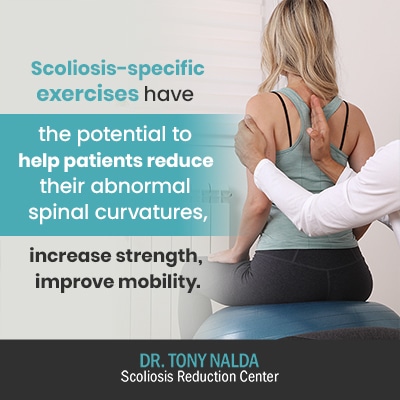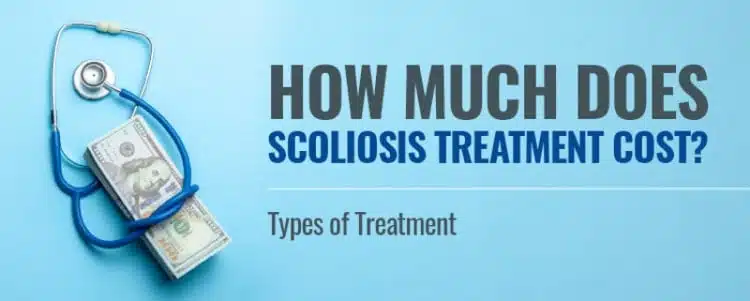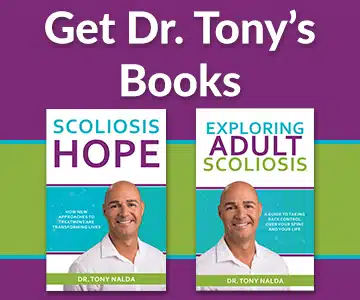While there is the monetary cost of scoliosis treatment, there is another treatment-related cost people should be aware of: the cost of not getting treatment, or the cost of a negative outcome. People who choose not to get treatment, or who choose a traditional passive route of watching and waiting, rather than a proactive route and conservative treatment, are likely to have a different experience of life with their condition.
When it comes to discussing the cost of scoliosis treatment, every case is different. Several highly-variable factors such as age, condition type, severity, and location of curvature will help determine the final cost of treatment. Also, the cost of scoliosis treatment is dependent upon the treatment approach chosen: traditional or conservative.
Before we get into the price ranges of different types of treatment, let’s first take a look at early detection and then move on to these different treatment approaches and the factors that characterize them, from diagnosis to potential treatment outcome.
Scoliosis and Early Detection
I’d like to start by taking a look at the topic of scoliosis and early detection because it addresses numerous key points of the condition’s nature.
When it comes to a progressive spinal condition like scoliosis, early detection is highly beneficial in terms of treatment success. This is because, as a progressive condition, scoliosis is going to get worse over time, if left untreated.
It’s important to catch scoliosis early, whenever possible, because it means reaching a diagnosis early on in the condition’s progressive line, meaning when the curvature is smaller and before the body has had time to adjust to the abnormal sideways spinal curvature.
When scoliosis is detected early, it gives us the best chance of developing a treatment plan that can make a big impact, and making a big impact is what we want to do. We want to reduce the abnormal spinal curvature on a structural level.
As we work towards reducing the abnormal curvature, we are restoring the spine’s overall health and biomechanics, which has the power to lessen/eliminate related symptoms.
Early Detection in Adolescent and Adult Scoliosis
While early detection is important, it’s not always easy to accomplish, especially in the condition’s most common form: adolescent idiopathic scoliosis (AIS).
AIS is diagnosed between the ages of 10 and 18, and scoliosis in children and adolescents is not a painful condition as they have not yet reached skeletal maturity; this is significant because when the spine is constantly growing, it is experiencing a lengthening motion, which counteracts the compression and related pain an abnormal spinal curvature can cause.
It is also children and adolescents that benefit the most from early detection as they are at a high risk of progression. Growth and development is the big trigger for progression, so adolescents entering into puberty, or children who are about to have a big growth spurt, are in danger of their condition worsening quickly.
When it comes to scoliosis in adults, as skeletal maturity has been reached, this means compression is likely to cause pain, and they are also less likely to progress rapidly.
In addition, there is a wide range in the severity levels of scoliosis: mild, moderate, and severe. Generally, mild, and even some moderate forms, don’t produce a lot of noticeable symptoms, such as postural changes, and this can also make scoliosis difficult for an average person to detect.
While the main benefit of early detection is to reach a diagnosis and start treatment, this benefit is only available to those who choose a treatment approach that believes in proactivity and starting treatment as close to the time of diagnosis as possible: a big dividing point between the traditional and conservative approaches we are comparing.
Two Main Scoliosis Treatment Approaches: Traditional and Conservative

Different scoliosis treatments will have different results, which is why the decision to commit to one approach over another can have life-long consequences.
On one hand, there is the traditional orthopedic approach, characterized by passivity, observation, bracing, and eventual surgery.
On the other hand, there is the chiropractic-centered conservative approach, characterized by proactivity, scoliosis-specific chiropractic care, and the integration of multiple treatment disciplines: chiropractic care, in-office therapy, custom-prescribed home exercises, and specialized, corrective bracing.
Clearly, I favor the latter, and here at the Scoliosis Reduction Center®, the positive treatment results experienced by our patients speak for themselves.
I want patients and their families to be empowered with the knowledge to make their own informed choices, with full awareness that different treatment approaches offer patients very different outcomes.
Let’s compare the traditional and conservative approaches from diagnosis to potential treatment outcome, and then we will compare the monetary cost of the different types of treatment; that way, you will be fully informed and able to make the best treatment choice for you and your family.
Diagnosing Scoliosis
As mentioned before, reaching a diagnosis is the first step towards treatment and results.
Traditional Treatment
While scoliosis screening at schools used to be widespread across the nation, it’s now up to each individual state, so this is an option for some, but not for everyone. For those with access to school screening, this would likely come in the form of a school nurse performing an Adam’s forward bend test.
As mentioned, it can be difficult to notice symptoms in milder forms of the condition, but if symptoms were noticed, a visit to a doctor, which would involve a physical exam and taking of the patient’s history would be the next step.
The cost of scoliosis treatment can vary depending on the type of treatment chosen and individual factors, making it essential to explore the various options available to determine how to fix scoliosis effectively while considering the associated expenses.
Scoliosis is typically confirmed with an X-ray and the patient’s Cobb angle. In order for scoliosis to be diagnosed, a patient has to have a Cobb angle measurement of 10+ degrees, plus rotation.
Conservative Treatment
While there’s not a huge difference in the diagnostic process of the two approaches in terms of sequence (taking of a patient’s history, physical exam, and scoliosis X-ray), there is a difference in the time apportioned to the process.
Here at the Center, we are known for providing more comprehensive exams that involve as much one-on-one time with the doctor as each patient needs. In fact, one of the biggest reasons behind a patient’s choice to come here for care is how willing we are to take the time and fully explain the diagnostic process, and what’s ahead, from beginning to end.
When it comes to the scoliosis X-ray, I would ensure I have multiple X-ray images to determine the size and nature of the abnormal spinal curvature in three dimensions.
As my occupational focus is scoliosis, I’m able to learn what I need to know about a patient’s condition through a comprehensive analysis of the scoliosis X-ray, conducting a thorough physical exam, and speaking to the patient about their medical history.
Through these steps, I’m able to move forward with designing a 100-percent customized treatment plan designed for each specific patient.
Treatment Goals
Obviously, the end-goal of anything is what guides its design and function, and scoliosis treatment is no exception.
If the motivation behind a given treatment approach is merely to give a patient with a crooked spine a spine that is straighter, how that is achieved could come at the cost of mobility and function; however, another approach that values function over curve size would have a person’s quality of life and mobility level as the motivation behind their treatment approach.
Again, different types of treatment offer different results.
Traditional Treatment
The idea of treatment success in the traditional approach is based on a patient’s curve not progressing to surgical level; in most cases, surgical level is reached once a condition reaches ‘severe’ status at 40+ degrees, and shows no signs of slowing progression.
The end-goal of the traditional approach isn’t to improve the condition itself, but rather to avoid a patient’s curvature getting to the point where scoliosis surgery is considered necessary.
Conservative Treatment
Here at the Center, our goal is correction. We work with patients and their families closely in our efforts to reduce a curvature as much as possible.
For us, treatment success is defined by our patients achieving significant measurable reductions in their spinal curvatures that don’t come at the cost of the spine’s health or function.
Observation
While monitoring a patient’s progression, plus how their spines are responding to treatment, is an important component of treatment, the traditional approach relies more heavily on observation.
Traditional Treatment
When a diagnosis is reached, most doctors following the traditional approach would recommend watching and waiting, instead of decisive action.
Observation tells the doctor whether the patient’s condition is progressing, and at what rate, but remember, as scoliosis is a progressive condition, it’s virtually guaranteed to get worse; to me, this is wasting valuable treatment time.
Conservative Treatment
I don’t believe the ‘watch-and-approach’ has much merit. To me, a diagnosis should spur decisive action to get ahead of the condition’s natural tendency to progress.
The sooner treatment is started, while the curvature is smaller and the body has not yet had a chance to adjust to the abnormal curvature, the better the chances of achieving a reduction are.
Bracing as a Component of Scoliosis Treatment
Bracing has long been used as a facet of scoliosis treatment, but the function and design of bracing has evolved over the years, and again, end-goal is an important defining feature.
Traditional Treatment
Generally, adolescents are fitted with a Boston or Milwaukee brace, but these braces have been around for decades and haven’t evolved in design or function. They are still mass-produced, rather than custom designed to address the specifics of each patient’s body type and condition.
These braces have the end-goal of slowing/stopping progression, rather than actually correcting the abnormal curvature.
In addition, traditional braces work by squeezing the spine, but related work of strengthening and stabilizing the spine, and the muscles supporting it, aren’t included.
Conservative Treatment
Bracing can be an important component of my treatment here at the Center; however, I use a highly corrective ScoliBrace, which differs greatly from the traditional braces used.
The ScoliBrace has a different end-goal. Instead of merely stopping or slowing progression, correction is the goal.
These corrective braces are designed specifically for each patient, making them more effective and comfortable to wear.
Instead of squeezing the spine and limiting its function, the ScoliBrace ‘pushes’ the spine in a corrective 3-dimensional manner.
 Scoliosis-Specific Exercises
Scoliosis-Specific Exercises
Staying fit and active is important for everyone, but for people living with scoliosis, and as a component of scoliosis treatment, it’s particularly important.
Custom-prescribed scoliosis-specific exercises are a means by which people living with scoliosis can remain active, while ensuring the exercises are safe and effective for their specific conditions.
Scoliosis-specific exercises are an important aspect of treatment as they are designed to stabilize and reduce curvature size.
Traditional Treatment
Many doctors of the traditional approach undervalue the place of exercise in scoliosis treatment.
In fact, patients traversing the traditional-treatment path are likely to have restrictions placed on physical activity and exercise.
Conservative Treatment
I’m a firm believer in the merits of custom-prescribed scoliosis-specific exercises as a cornerstone of treatment and recovery; these exercises have the potential to help patients reduce their abnormal spinal curvatures, increase strength, and improve mobility.
I always recommend my patients stay as active as is safely possible; this has huge benefits in terms of augmenting treatment results, sustaining those results, and increasing strength and flexibility in the spine and the muscles that are charged with stabilizing and supporting it.
In addition, a body that is stronger and more agile is going to respond better to the rigors of treatment and life with a progressive spinal condition.
In-Office Therapy
In-office therapy, also known as physical therapy, works with other treatment disciplines such as exercise, bracing, and chiropractic care to reduce abnormal spinal curvatures, increase strength, and improve function.
Traditional Treatment
In-office therapy is rarely recommended along the traditional-treatment route as it’s contrary to the passivity of its watch-and-wait approach.
Conservative Treatment
Scoliosis-specific in-office therapy is an integral component of our treatment approach here at the Center.
We use a variety of specialized pieces of equipment, such as our scoliosis traction chair, paired with a wide range of modalities that help mobilize the spine in a corrective position. This type of therapy works towards reducing an abnormal spinal curvature by creating a mirror image of the patient’s condition.
Of course, this only works if each and every patient has their own customized in-office therapy approach, which is precisely what we offer our patients.
Scoliosis Surgery
Traditional scoliosis-treatment ideology says that surgery is ultimately the only effective method for treating scoliosis; conservative treatment ideology sees spinal-fusion surgery very differently.
When considering scoliosis treatment, understanding the cost implications is vital. The expenses can vary significantly depending on the type of treatment, which may encompass scoliosis surgery, kyphosis surgery, or other options. It’s important to weigh the cost against potential benefits and consider the implications of scoliosis surgery, including both its side effects and success rate, to make an informed decision regarding the most suitable and cost-effective treatment for your specific case.
Traditional Treatment
It’s important for patients to be aware that if they are on the traditional path of scoliosis treatment, that path is most likely to eventually lead to costly and invasive surgery.
The watching and waiting only increases the already-high likelihood of a condition’s progression. This brings patients closer to that surgical-level threshold and the recommendation that spinal fusion is necessary and the best option.
Even if surgery is successful in terms of stopping progression, which there is never a guarantee of, that comes at the price of strength and mobility, not to mention the risk of side effects and additional complications that accompany any surgical procedure.
There is also a real gap in data on long-term effects of spinal-fusion surgery, and this is an important factor to consider.
Conservative Treatment
As mentioned earlier, this is a big dividing point between the traditional approach and my conservative approach; the end-goal of my treatment is to avoid surgery at all costs.
In fact, everything I do as a scoliosis chiropractor is to help patients reach improvement through more natural and less-invasive means so they never know the hardships associated with the higher stages of progression and back surgery.
Different Treatment Approaches Equal Different Results
So now that you understand the difference in the two main scoliosis-treatment approaches, you can see what wildly different results they can produce.
These results aren’t just limited to the body, but of course, the lives of patients who either have potential complications and/or the loss of mobility that spinal fusion is associated with to live with, or those who have preserved the health and function of their spines through more natural and less-invasive treatment methods.
While traditional scoliosis treatments are well established, that in no way means they are superior to other modern and alternative approaches, such as the conservative approach offered here at the Scoliosis Reduction Center®.
Now that we have talked about the other types of costs associated with the different treatment choices, let’s take a look at the monetary costs of each approach.
How Much Does Scoliosis Treatment Cost?
As mentioned earlier, there is more than just the monetary cost of scoliosis treatment; there is the cost of not getting treatment and leaving a progressive spinal condition to get worse and more complex and difficult to treat, and there is also the cost of different treatment results.
While spinal-fusion is appealing to some because it means going into surgery with a crooked spine, and assuming it’s a success, coming out with one that is straighter, but what is the true scoliosis surgery cost?
Remember, once spinal fusion has taken place, there is no going back. If the surgery is unsuccessful or a patient develops complications or severe side effects, such as pain and loss of flexibility in the fused portion of the spine, there is little recourse other than more surgery.
With the conservative approach, it is natural and noninvasive, meaning that it carries few, if any, side effects or risk of complications contrary to surgery. If a patient is unhappy with our results, there are no permanent effects of treatment, and they are free to try another approach.
My advice is to always try the less-invasive and safer options first.
Below is a chart providing ranges of scoliosis-treatment costs, but keep in mind these are ranges. Every case of scoliosis is different, and final cost is determined by multiple varying patient characteristics such as age, responsiveness to treatment, condition type, curvature location, and condition severity.
The Cost of Scoliosis Treatment
| Treatment | Conservative Route – Scoliosis Reduction Center® | Traditional Route – Towards Surgery |
| Scoliosis Evaluation | $200 to $300 for a comprehensive in-office evaluation | $1,000’s for a short consultation with a surgeon |
| In-Office Therapy, Rehabilitation, & chiropractic Care | $300 for a 3-hour session (approximately 10 to 20 visits recommended on average) | Not offered |
| Scoliosis Brace | Only 25 to 30 percent more for a custom corrective ScoliBrace | Poorly manufactured, mass produced Boston or Milwaukee brace (not custom) that squeezes the body/spine: $2,500 to $2,600 |
| Home Rehab & Equipment | $700 to $1,000, plus it saves a patient thousands of dollars because they can do the care in the comfort of their own home, rather than being office-dependent | Not offered |
Scoliosis Surgery Not offered Anywhere from $140,000 to $175,00 (with cost increasing with complications or increased recovery time in hospital)
Conclusion
The cost of scoliosis treatment can vary widely depending on several factors, including the chosen treatment approach and the severity of the condition. Mild cases of scoliosis, often considered when the curvature is less than 10 degrees, may be managed with non-surgical methods such as physical therapy or bracing, which tend to be more cost-effective. On the other hand, extreme scoliosis cases may require more intensive treatments, potentially including surgery.
The cost of surgery can be significantly higher, and it’s crucial to consider the specific procedures and follow-up care involved. Additionally, some specialized centers like the Scoliosis Reduction Center® may offer unique approaches to scoliosis treatment, and their costs can vary from traditional methods. When exploring the best treatment for scoliosis, it’s essential to consult with healthcare professionals and inquire about the financial aspects to make an informed decision.
Receiving a scoliosis diagnosis can bring a flood of questions and fears. From wanting to know how much worse the condition can get, to what sacrifices a person will have to make, and how much treatment will cost, these are no small concerns.
The cost of scoliosis treatment can vary widely depending on factors such as location and age, with specialized options like Miami scoliosis treatment and Orlando scoliosis treatment offering tailored approaches for adult scoliosis and scoliosis treatment by age group.
What I want every patient, and their families, to know is that the traditional-treatment route is neither the best, nor the only choice. The difference between the traditional and conservative routes are significant, with each offering patients a highly-different outcome.
Here at the Scoliosis Reduction Center®, I know our approach is effective because I see the results. I see patients who have worked hard, committed, and have reduced their curvatures by methods that preserve the strength and function of the spine.
The patients who come to me out of disappointment in the results of their spinal fusion are very different situations. These patients might have a smaller curvature, but that comes at the cost of their spine’s health and function. Also, many of these patients experience an increase in pain levels post-surgery, which is something many are unprepared for.
In addition, there are the monetary costs associated with the different forms and facets of scoliosis treatment, and these can also factor into a patient’s choice of which treatment route to take.
Through my chiropractic patient-centered conservative approach, I’m able to help patients work through their conditions in ways that bring improvement, healing, and hope for the future.





